
Database of the Month: InCites Journal Citation Reports
June 15, 2016
How to find journal relationships in InCitesTM Journal Citation Reports® from Web of Science
InCitesTM Journal Citation Reports® (JCR) measures research influence and impact at the journal and category, or academic subject, levels and shows the relationship between citing and cited journals. In addition, the JCR® now includes an interactive graphic showing the relationship between citing and cited journals making it easier to visualize the strength of that relationship. Here is a step-by-step guide to finding the relationships between journals in Journal Citation Reports®
- Choose Journal Citation Reports® (JCR) from the list in Databases A to Z.
- On the Web of Science page, click Journal Citation Reports® at the top of the page.
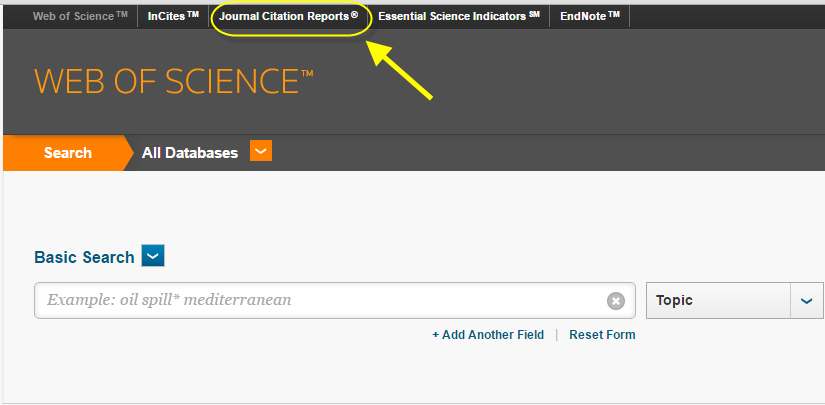
- Type the title of the journal you would like to compare with other journals in the box under Go to Journal Profile and click the search icon.
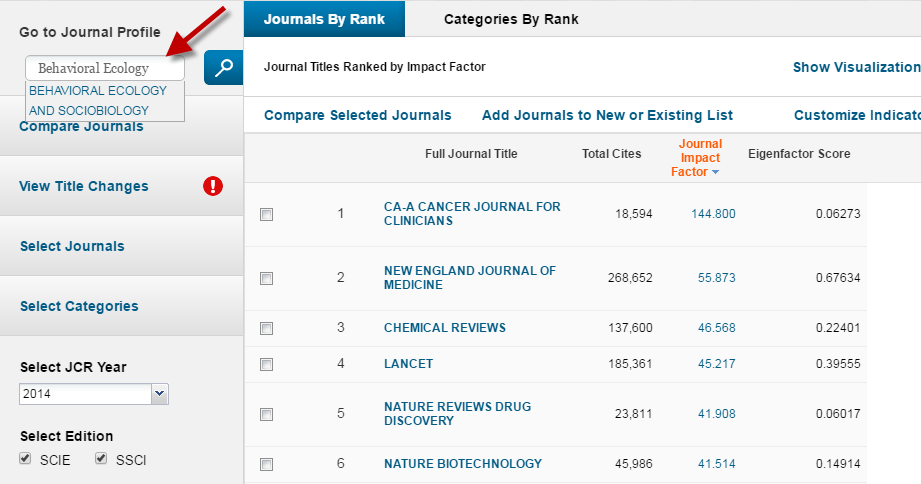 Within the Journal Profile you will be able to:
Within the Journal Profile you will be able to:
- Sort journal data by clearly defined fields: impact factor, immediacy index, total cites, total articles, cited half-life, or journal title
- Sort subject category data by fields such as, journal title, impact factor, JCR year, and publisher
- Determine the cited half-life of a journal in a given JCR year
- Determine how many citations a journal received in the JCR year (Cited Journal Data) and how many citations a journal made to other journals (including itself) in the JCR year (Citing Journal Data)
- Graphically visualize displays of the citing or cited data relationships between the parent journal and the top twenty journals in its field
- Link to Ulrich’s Global Serials Directory to find detailed information about the journal’s language of text, content type, abstracting & indexing coverage, online availability, audience and reviews.
- Let’s take a look at Cited Journal Data (inbound citations) and Citing Journal Data (outbound citations) to establish the relationship of the journal, Behavioral Ecology and Sociobiology, to other journals in its subject areas through citation patterns and distribution.
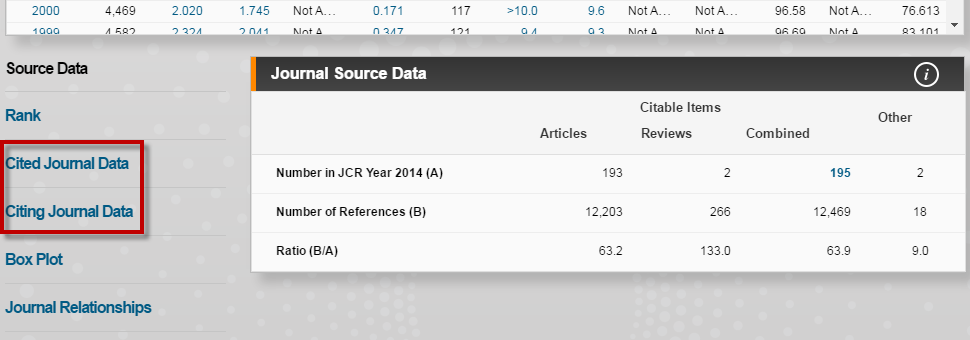
Click on Cited Journal Data – the Cited Journal Graph shows the distribution by cited year of citations to articles published in Behavioral Ecology and Sociobiology.
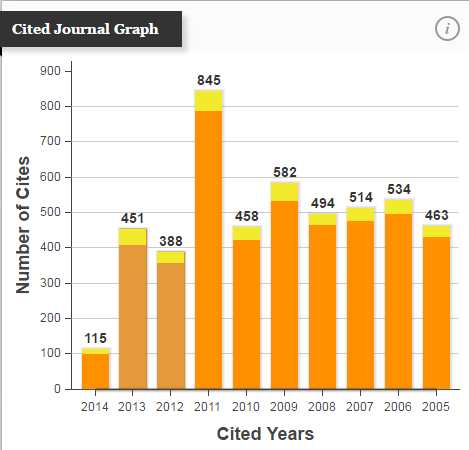 The top (yellow) portion of each column indicates journal self-citations: citations from articles in Behavioral Ecology and Sociobiology to articles in the same journal.
The top (yellow) portion of each column indicates journal self-citations: citations from articles in Behavioral Ecology and Sociobiology to articles in the same journal.
The bottom (orange) portion of each column indicates non self-citations: citations from Behavioral Ecology and Sociobiology to articles in other journals.
On the Cited Journal Data table, journals that cited Behavioral Ecology and Sociobiology in a given JCR year are listed in order of occurrence. The table above shows that in 2014, the journal PLOS One cited sixty-two (62) articles published in Behavioral Ecology and Sociobiology in 2011. - Now let’s look at the Citing Journal Graph. The Citing Journal Graph shows the distribution by cited year of citations from articles in Behavioral Ecology and Sociobiology. All of the citing articles were published in the JCR year.
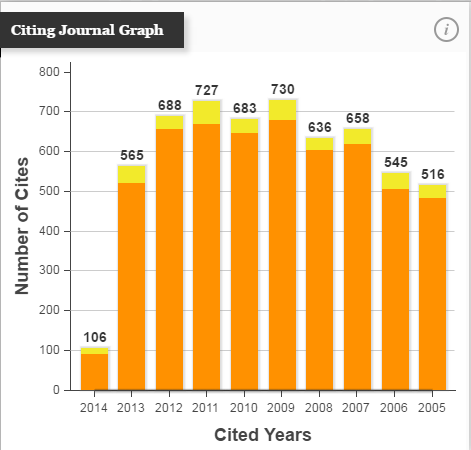 The top (yellow) portion of each column indicates journal self-citations - citations from articles in Behavioral Ecology and Sociobiology to articles in the same journal. The bottom (orange) portion of each column indicates non-self-citations - citations from Behavioral Ecology and Sociobiology to articles in other journals.
The top (yellow) portion of each column indicates journal self-citations - citations from articles in Behavioral Ecology and Sociobiology to articles in the same journal. The bottom (orange) portion of each column indicates non-self-citations - citations from Behavioral Ecology and Sociobiology to articles in other journals. - The Citing Journal Data table reveals a journal's subject specialty, points to its closest peer or competitor publications, and highlights the network of journals within a particular field or fields. Citing Journal Data table identifies those publications that were most frequently cited by Behavioral Ecology and Sociobiology for a given year – outbound citations. In this table, the citing journal is Behavioral Ecology and Sociobiology, and all of the citing articles were published in 2014. The journals cited by articles in Behavioral Ecology and Sociobiology are listed in the Cited Journal column.
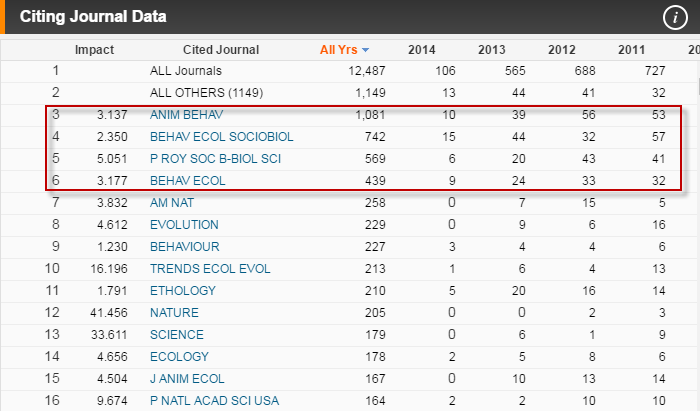
- Web of Science has made it easy to visualize the relationships between journals and their subject categories through its Journal Relationships link.
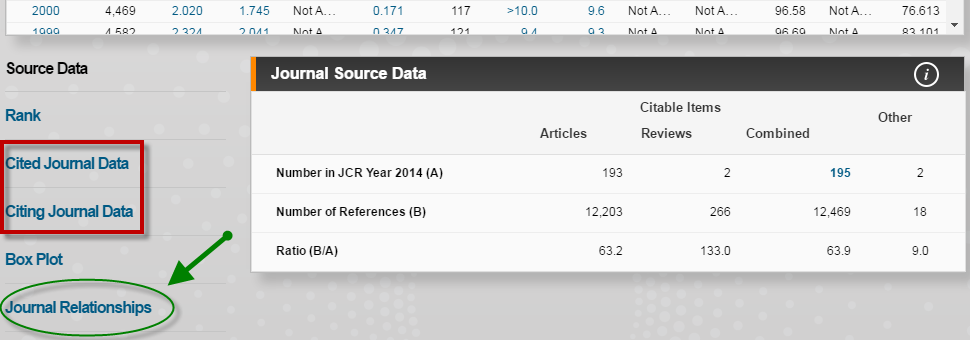 On the Journal Relationships diagram, the top twenty cited or citing journals are displayed as arcs on the circle. The size of each arc is indicative of the relative citation relationships to that journal. The thickness of the chords connecting the arcs is demonstrative of the strength of citation relationship between the journals. The Journal Relationships diagram includes several interactive features:
On the Journal Relationships diagram, the top twenty cited or citing journals are displayed as arcs on the circle. The size of each arc is indicative of the relative citation relationships to that journal. The thickness of the chords connecting the arcs is demonstrative of the strength of citation relationship between the journals. The Journal Relationships diagram includes several interactive features:
- Hover over arcs to display the journal Impact Factor;
- Hover over over chords to display the citation relationship to the parent journal;
- Click the title of any journal in the arc to go straight to that title's profile page;
- Click the title of any journal in the arc to go straight to that title's profile page;
- Let’s select Cited Data from the drop down arrow next to the word Data to find the top 20 journals that have the strongest relationship to Behavioral Ecology and Sociobiology. The chords, connecting the citing journals, display the number of contributed citations. Click on another journal arc to reveal connections between that journal and others within Behavioral Ecology and Sociobiology relationships. The widest arcs represent the strength of the relationships. The wider the arc, the stronger the relationship between journals.
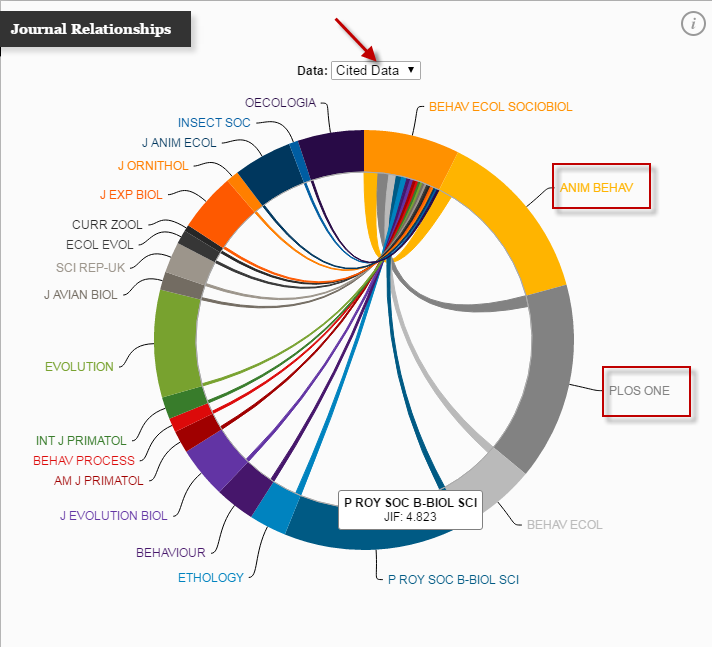 In the example above, the journals Animal Behavior and PLOS One each contributed a high number of citations to Behavioral Ecology and Sociobiology than other journals in this network. Hovering over the chord between these connected journals will reveal the number of citations in the connection.
In the example above, the journals Animal Behavior and PLOS One each contributed a high number of citations to Behavioral Ecology and Sociobiology than other journals in this network. Hovering over the chord between these connected journals will reveal the number of citations in the connection.
Hovering over the citing journal’s arc in the circle will reveal a journal’s impact factor. For example, the Proceedings of the Royal Society B-Biological Sciences, a citing journal, has an impact factor of 4.823. A journal’s impact factor (JIF) is an indicator of the importance of a journal to its field. The higher the impact factor, the greater the perceived importance of the contribution this journal – and in turn, its related journals – has on its academic or research fields.
Learn More
To learn more about what InCitesTM does and does not do, go to Angela Cochran's Interview with Thomson Reuters: InCites Platform Offers New Analytics and Transparency at The Scholarly Kitchen.
Database of the Month provides a very brief introduction to library databases and selected web resources, highlighting key features of the database that you should know about. If you would like assistance using this database, please schedule a research consultation using this form. For more information about the library's databases contact the Reference Desk.
